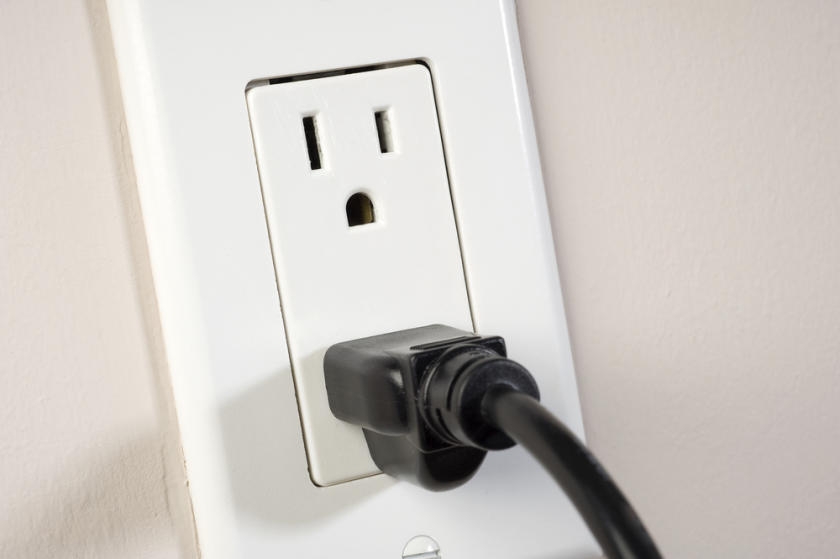Placing an old light switch or electrical outlet is a simple DIY update that almost anyone can do. However, because electricity is involved, it’s not a project to be taken lightly. As long as you take the steps to stay safe, all you need is a screwdriver, a new outlet/switch, and about 15 minutes of your time.
Step 1: Turn Off Power
The very first thing you should do before replacing any light switch or electrical outlet is to deactivate power to the circuit. Turn off power at your home’s main electrical panel by finding the appropriate breaker and flip it to the “off” position. If you’re not sure which breaker is which, turn off power to the entire house. Then turn the light switch on to double-check that the circuit is off.
Safety Alerts!
Never trust an inoperable light switch as a sign that the circuit is off.
Make sure the circuit is truly “dead” before touching any wires or terminals. Check for a current again with a high-voltage neon tester before working. Test from the black wires to a grounded metal box or other good ground, then to the white wires. Also, test from the white wires to a ground. Be sure your tester is functioning by first trying it in a live receptacle.
After turning the breaker off, cover it with a piece of electrical tape to ensure that no one will turn it on while you’re working.
Step 2: Remove Old Light Switch or Electrical Outlet
Remove Cover Plate
Remove the cover plate by loosening its screws with a screwdriver and then pop it off. Remove the old light switch or electrical outlet from the electrical box inside the wall by unscrewing the screws that anchor it to the box. Carefully pull the switch or outlet out of the box.
Safety Alert!
If you are changing a very old switch, wires may be loose or brittle. Be careful that they don’t break and then become too difficult with which to work.
Disconnect Wall Wires
Disconnect the wall wires from the switch by loosening the terminal screws. These screws secure the “hooked” end of the wires to the switch’s terminals.
Single-pole switches have three wires: Usually one black (hot), one white (neutral), and a separate ground wire (usually green or bare copper wire). Note that some older homes do not have a ground wire. In addition, if this light switch or electrical outlet is in the middle of a circuit, there will usually be two white wires. Take note of how the wires are connected to the existing switch/outlet you are replacing so you can connect the new switch the same way.
Trim Excess Bare Wire
Use a wire cutter to trim off the excess bare wire that extends past the plastic insulation. Do this on every wire unless this shortens the wires too much (you’ll only have a few inches of wire to work with). Then use a wire stripper to strip off 3/8″ of insulation from every wire. This will give you a clean wire end for the connection to the new switch.
Step 3: Connect New Light Switch or Electrical Outlet
Connect Wall Wires to New Switch or Outlet
Connect each of the wires from the electrical box to their corresponding terminals on the new switch/outlet. Consult the manufacturer’s instructions to be sure you’re making the right connections for your particular switch. Generally, the black wire connects to the brass screw, the white wires connect to the silver screws and the ground connects to the green screw on the bottom of the switch.
For each connection, use needle-nose pliers to twist each wire end and bend it into a hook shape. Wrap this hook around the terminal screw and then tighten the screw with a screwdriver.
Helpful Tip
Use the needle nose pliers to hold the hooked end of the wire under the terminal screw head as you tighten the screw down.
Secure Connections
Gently pull each connection to make sure they are secure. Wrap electrical tape around the switch so that the tape covers each of the connections. This makes the connections even more secure and safe.
Screw Light Switch or Electrical Outlet into Place
When all wires have been connected and the connections taped, bend them in a zigzag pattern so that they will easily fold into the wall box. Push the light switch or electrical outlet back into place. Tighten the two screws that hold it in position in the electrical box using a screwdriver.
Helpful Tip
Be careful not to over-tighten the terminal screws. You risk damaging the switch.
Step 4: Restore Power and Test
Return power to the circuit and test the light switch or electrical outlet to make sure your installation was correctly done. If it doesn’t work, turn off the breaker again and double check your connections. If it works, install the new switch/outlet plate and screw it into place using a screwdriver.
You’re done! Now you can replace light switches and electrical outlets whenever and wherever they’re needed.
Project Shopping List
Here’s what you’ll need to complete this project successfully.












